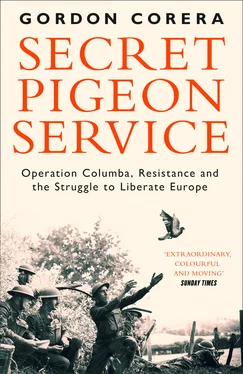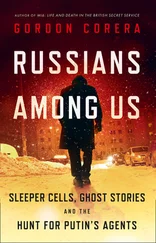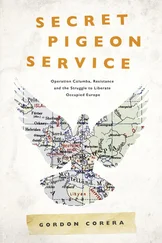1 ...6 7 8 10 11 12 ...17 The RAF’s victory in the Battle of Britain meant the summer of 1940 passed without invasion. The Luftwaffe had proved a fearsome weapon but not, as Hitler had claimed, one against which it was impossible to prevail. The German navy had insisted that air superiority was a vital prerequisite for invasion. Nor had there been enough time to prepare the right type of craft to transport the Wehrmacht over the Channel. But the leadership of MI14 remained convinced that invasion was likely in 1941.
Their job of detecting preparations was complicated by a German decision to keep up the constant menace of the possibility of invasion, so as to maintain pressure on Britain. This meant Germany was ensuring that activity was visible and that fake intelligence was passed to Britain through military attachés and other channels. As the spring of 1941 began, the fear that German landing craft would soon be arriving on the British coast was still real. Sources reported details of preparations such as the training of parachutists, and even the intensive manufacture of gas. By May 1941, MI14 were still seeing reports of a possible invasion, with June to August appearing to be the most likely time. Reports from Belgium talked of the training of troops wearing British uniforms and the possible construction of barges.
The reality was that Germany had backed away – but no one in London knew that for sure, partly because the intelligence picture remained so poor. Details of the German military in Belgium and the Netherlands remained ‘very unsatisfactory’, the Director of Military Intelligence told MI6 in February. ‘We have no confirmed evidence of the number of divisions located at any time in these countries … With invasion more than likely at any time after a month from now this is a most serious situation.’
From the spring of 1941, there was a new source for the analysts in London – Columba. For Brian Melland and Sandy Sanderson at MI14, Columba was not a source whose reports were passed on to them like the human intelligence of MI6. It was their own source. Rex Pearson looked after the logistics, but Melland and Sanderson were given the job of overseeing the operation. They were the ones who decided what questions would be asked in the questionnaire; in what areas the pigeons would be dropped; and who evaluated the material when it came back. They were able to handle the resulting intelligence direct. And – most remarkably – it was intelligence so fresh you could almost smell it. It would be in their hands within hours or days of someone observing something.
Two days after the initial drop in April, the phone rang at the War Office. On 10 April the first bird had made its way home to Kent. Columba message number one was phoned back to Melland and Sanderson at the War Office at 10.30 a.m.
The message was from a small village called Le Briel in the commune of Herzeele in northern France, not far from the Belgian border. It might have been short but it contained real information. ‘Pigeon found Wednesday 9th at 8am’, it began. ‘The German troop movements are always at night. There are 50 Germans in every Commune. There is a large munitions dump at Herzeele 200 metres from the Railway station. Yesterday, a convoy of Horse Artillery passed towards Dunkirk via Bambesque and another to Hasebrouck. The Bosches do not mention an invasion of England. Their morale is not too good. The RAF have never bombed these parts. They should come to bomb the brick works as the proprietor is a …’ The next word is written up as ‘illegible’ by the translator, but one wonders if that was actually to avoid the blushes caused by a cruder word the Frenchman might have used about a collaborator.
And then the message ended with one of those phrases that spoke of something in the spirit during those dark days in France. ‘I await your return, I am and remain a Frenchman.’ It was signed ‘ABCD34’. This was precisely the type of intelligence the team had been after. It was a good start, a relief for the team who had backed Columba.
That same day at 3 p.m. came message number two, this time unsigned, from Flanders. ‘There are only a few troops here and no petrol dumps, but yesterday some artillery arrived and the men say they are going to Yugoslavia where other troops and wagons are also moving.’ Columba was working, although it took another nine days for the next message to arrive.
The next drop took place on 6 May and was less successful. One message simply brought greetings from West Flanders. Below was the slightly forlorn comment: ‘Through a mishap this bird lost the questionnaire en route as did a number of others which have returned empty.’ Another from the same batch mentioned some aerodromes but, as would often be the case, provided too little detail to locate them.
Resistance is often portrayed as a stark choice. A choice between a life of danger on the run or one of collaboration. But in reality, it was a much broader spectrum. People could and did resist in small ways and large. That was evident from those who chose to take the risk to send a message back via Columba. Some of those early messages were short – ‘No troops here’ was all one said, without even saying even roughly where ‘here’ was. Others wrote just a few lines with a plea for help, while making clear the individual understood the risks involved. ‘Although this may cost me my head if one of the damned Boches saw me take the bird to my house, I will release the pigeon again with information for you,’ they wrote.
Most pigeons were found early in the morning by farmers tending their land. The messages sometimes showed daily rural life continuing as if war had barely intruded. ‘I found this pigeon on the 6th early in the morning while I was cutting clover for the animals and I have looked after it well and given it food and drink and am now anxious to know if the little animal reaches its loft … Hoping that I have possibly rendered you some service.’ Often the finders were illiterate or unsure of what to do and would confide in a local priest, schoolmaster or someone else whom they trusted. That was often when the best intelligence came.
In some cases the pigeons found their way to people already trying to organize some kind of resistance. In July 1941, a writer said he was part of a group of eleven patriots in a position to give important information. A parachutist who had recently been dropped above Carpiquet in Caen was safe and sound but the person who had sheltered him had been denounced and was going to be shot. ‘From now onwards we will take direct action against such person in striking down anyone who betrays,’ they wrote. Columba was revealing that there were many in Europe who wanted to do something – some were willing to send a short message back, while others were already looking for ways to do more. There was potential there to be tapped.
Food was one recurring theme. The Germans took around 70 per cent of pre-war food production and the results were severe. Messages spoke of hunger and starvation. One writer in May said the pork butchers had all been closed because all the pigs had been sent to Germany and there was precious little other meat. ‘If it lasts much longer we must starve,’ one Belgian wrote, ‘try to free us as quickly as possible.’ In Brussels a writer said that the rations for the previous month had been 5 kilos of potatoes plus 225 grams of bread per day: ‘too much to starve but not enough to live.’ Potatoes were being requisitioned to be sent to Germany, they wrote, so people would dig them up and eat them before they were ripe. There were complaints of some French peasants profiteering and selling on butter and eggs to the Germans at high prices. Also evident were signs of small acts of resistance. One writer in Flanders recorded that a local farmer had hung a dead hen outside with a written note on it saying he would rather his hens were dead than lay eggs for the Germans. (The same author ended his message with the phrase ‘I do hope this is not a German pigeon’.)
Читать дальше












